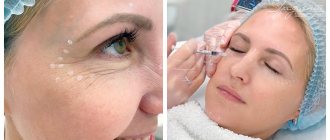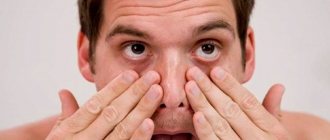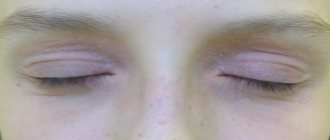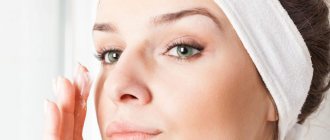The eyelids are movable folds of skin that protect the visual organs from dryness, dust, bright light and other negative factors surrounding a person. Thin and sensitive skin in this area is penetrated by many blood vessels. Beneath it there is muscle tissue that facilitates easy opening and closing of the eyes. In the depths of the eyelid, the meibomian glands are localized, producing a liquid secretion that moisturizes the visual organs and improves the contact between the eyelids and the surface of the eye.
The conjunctiva with the lacrimal glands contributes to additional hydration of the eyeball, and it also protects the eyes from infectious lesions.
Various eyelid diseases include processes caused by inflammation, degeneration or atrophy, as well as pathologies of the neuromuscular system, tumors and circulatory disorders.
Acute infectious diseases
Abscess and phlegmon
These are infectious eye diseases in which a cavity filled with purulent contents forms on the eyelids. Provoking factors for the development of diseases are barley, boils, inflammation in the maxillary sinuses, ulcerative blepharitis, damage to the skin near the eyes, meibomitis.
Clinical manifestations:
- skin redness;
- swelling of the eyelid;
- area tension and pain.
When the cavity is opened (spontaneously or surgically) and the pus is removed, the inflammatory process quickly stops. Drug therapy consists of taking bactericidal and bacteriostatic agents in the form of eye drops or intramuscular injections.
Erysipelas of the eyelids
The cause of the development of the disease is often a hemolytic streptococcal infection, and in some cases, infection with other microorganisms. Inflammation, as a rule, begins in a number of areas of the face, after which it affects the eyelids.
Symptoms:
- intense pain syndrome;
- increased body temperature;
- chemosis of the conjunctiva.
If treatment is started in a timely manner, the outcome is favorable in most cases. For drug therapy, antibacterial drugs (penicillins) for intramuscular injections, vitamin complexes, and Streptonitol ointment are prescribed.
Furuncle
This disease of the eyelids is a purulent necrotic inflammation of the hair follicle and adjacent tissues. The cause of development is staphylococcal infection. The inflammatory process affects the eyebrow area, in rare cases it is localized in the corner of the eyelid.
Clinical manifestations are the formation of a dense edematous node, accompanied by pain. After a few days, a necrotic core forms in its central part, after which it is opened and purulent contents are released. Then the wound heals and a scar forms.
Drug therapy is carried out with antibacterial drugs for internal use or intramuscular injections. The edges of the eyelids and the skin near the affected area are treated with camphor alcohol or hydrogen peroxide. If purulent inflammation spreads, surgical opening is recommended.
Chronic infections
Tuberculous lupus is a chronic infectious disease of the eyelids. The disease affects the skin of the face in most cases, but can also spread to the eyelids.
Symptoms:
- the formation of translucent pinkish-yellow small tubercles;
- eversion of eyelids;
- inability to close eyelids;
- trichiasis (abnormal direction of eyelashes towards the eyeball).
General anti-tuberculosis treatment is prescribed. Desensitizing drugs are used. If no complications occur, therapy lasts up to six months.
Herpetic diseases
The course of herpetic dermatitis of the eyelids in most cases does not differ from ordinary herpes or herpes zoster.
The pathology is characterized by an acute onset of development. The following symptoms occur:
- redness and swelling of the eyelid;
- the appearance of transparent bubbles, which then burst;
- the formation of crusts at the site of burst blisters.
After 7-14 days, the crusts disappear, leaving no traces. A relapse of the disease is possible.
Therapy: the blisters are treated with brilliant green. When crusts form, oxolinic ointment or Zovirax cream is applied to them. To prevent secondary infection, local antibacterial agents are used.
Allergic diseases of the eyelids
Allergy dermatitis occurs due to a reaction to medications or cosmetic products. Its development takes about 6 hours from the moment the allergen begins to act. Symptoms that accompany this condition:
- redness and swelling of the eyelid;
- vesicular or bullous rashes that can cause maceration of the skin.
Therapeutic measures involve eliminating the effect of the substance that triggered the development of the allergy. Use local corticosteroids (not containing antibacterial components). Desensitizing drugs are prescribed for internal use.
Eczema
Inflammation of the eyelids, accompanied by itching and rashes. Usually takes a chronic form.
Symptoms include swelling of the eyelid skin and the appearance of small blisters. When they burst, serous exudate comes out, after drying, yellow crusts form. A long course of the disease can lead to thickening of the eyelid, as well as its eversion. Eyelashes may fall out.
Acute forms are treated with lotions of cool lead water and boric acid solution. When the inflammation subsides, topical corticosteroid drugs are used.
How to properly care for the skin around your eyes? Advice from a dermatologist
The skin around the eyes is delicate and thin, and therefore requires special attention. The head of the dermatology office of the National Medical Research Center for Therapy and Preventive Medicine of the Russian Ministry of Health, a doctor of the highest category, Irina Aleksandrovna Tagantseva, spoke about how to properly care for her.
The skin around the eyes has structural features. This is the thin outer layer of the epidermis, with an abundant microvascular network and a thin layer of subcutaneous fat. We constantly blink, which creates additional stress on the orbicularis oculi muscle. In addition, the skin condition is affected by the proximity of the corneal mucosa, imperfections of the sebaceous glands and hydrolipid film, and mechanical damage: applying and removing makeup, etc. This can lead to early (after 20-25 years) signs of aging, wrinkles, sagging skin, congestion of the venous and lymphatic network. Negative manifestations intensify against the background of fatigue, illness and stress. Dark circles and bags appear under the eyes.
The skin around the eyes needs careful care: special cleansing products (with neutral ph) and low-lipid products. Please note that products must undergo dermatological testing.
It is important to apply the products delicately, and also follow the rules for removing makeup from the eye contours: wipe with a separate cotton pad from top to bottom from the inner corner to the outer along the upper eyelid. Then we remove the remains under the lower eyelids, moving from the temple to the nose.
Tips for caring for the skin around the eyes:
If wrinkles and dryness appear, apply a few drops of cream with the pad of your fourth finger;
for obvious signs of aging, use a cream that increases elasticity;
to eliminate congestion and disguise dark circles, choose a cream with a high content of arnica extracts;
to remove morning sleepiness from the eyes, special disposable masks with patches based on cornflower, chamomile, arnica, and calendula are suitable;
for irritation, redness and itching, a restorative anti-inflammatory cream is recommended;
for expression lines, creams are applied that tone the skin and muscles around the eyes.
If you have skin problems, consult a specialist. You can make an appointment with dermatologists at the National Medical Research Center for Therapy and Preventive Medicine of the Russian Ministry of Health by phone.
Fungal diseases
Candidiasis
Lesions on the skin of the eyelids occur due to exposure to yeast-like fungi of the genus Candida. The disease is accompanied by swelling of the eyelids, redness, and the appearance of small pustules. Therapy is carried out by treating the affected areas with nystatin ointment and taking nystatin internally.
Trichophytosis (ringworm)
The cause of the disease is fungi of the genus Trichophyton. Clinical manifestations are hyperemia and swelling of the eyelids, the formation of pustules and yellow crusts. A coating of spores appears on the eyelashes. In some areas of the eyelids, eyelashes fall out or break off.
It is possible to develop concomitant diseases – conjunctivitis or keratoconjunctivitis.
During therapy, the affected area is treated with a solution of alcohol and iodine. Griseofulvin is recommended for internal use.
Actinomycosis
The disease is caused by actinomycetes (radiant fungi). A dense knot forms in the outer or inner corner of the eyelid, but there is no pain. Over time, it softens and forms an intradermal infiltrate, after opening which a fistula with purulent discharge remains (it does not heal for a long time). Antibacterial therapy and actinolysate are prescribed. An x-ray is taken, the abscess is opened and scraped out.
Meibomian gland diseases
Meibomian are the sebaceous glands located in the cartilage of the eyelids. When coccal flora gets into them, they become inflamed, the edges of the eyelids thicken, the skin turns red, and yellow crusts appear on the eyelashes. This disease is called meibomitis. When the secretion of the meibomian gland penetrates into the conjunctival cavity, chronic conjunctivitis develops.
For therapy, the eyelids are treated with alcohol or brilliant green. Dexamethasone or antibacterial instillations are performed. Apply local antibacterial agents to the skin. Sometimes the affected cavity is opened surgically.
Chalazion
A disease characterized by the formation of a dense formation in the cartilage of the eyelid. The cause of this phenomenon is chronic meibomitis. Several chalazions can form simultaneously.
At the first stages, the chalazion is a small nodule, which over time increases to 5-6 mm. The skin above it rises, the eyelid is slightly deformed. If you press on the node, you will notice a dense formation, but no pain is felt. The conjunctiva in the affected area rises, thickens, and turns red. Subsequently, it may become thinner and break through, after which the contents of the nodule come out.
During therapy, drops of hydrocortisone emulsion, antibacterial solutions, and local preparations are used. Dry heat recommended. If such measures do not help, surgical treatment is resorted to. Small nodules sometimes resolve on their own.
Features of the skin around the eyes
The skin around the eyes has the following characteristics:
- the dermis is thin;
- a small number of sweat glands;
- comparatively smaller amount of collagen;
- there are many facial muscles, thanks to which the eyelids and skin of this area move normally.
Scientists have calculated that a person's eyes make more than 10 thousand blinks and squints per day. It is these features and the increased activity of facial expressions in the periorbital region that contribute to the rapid aging of the skin. In this area, a greater accumulation of mast cells is recorded, which explains the reactivity of the dermis around the eyes and the frequent formation of allergies.
Developmental defects of the eyelids
Coloboma
An anomaly of the visual organ, manifested in the absence of some eye membranes. It occurs more often on the upper eyelids, less often on the lower eyelids.
Coloboma in most cases has the shape of a triangle, in which the base is the edge of the eyelashes. Since the anomaly affects all areas of the organ of vision, a concomitant symptom is the absence of eyelashes and glands.
Most often this is a congenital pathology, but it can develop after injury or other diseases. Coloboma is very dangerous for the visual organs, as it leads to degeneration of the cornea and other complications, including blindness.
The most effective method of treating the pathology is surgery, in which the affected tissue is excised, after which the musculocutaneous flap is moved to the site of the anomaly. With the help of plastic surgery, the correct edge of the eyelid is formed.










